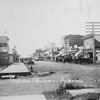Early Settlement

The city of Grande Prairie is named for the large open prairies lying to the north, east, and west of the settlement. It is one of Canada’s fastest growing cities and as of 2007 Grande Prairie had a population in excess of 50,000. It is the largest city between Edmonton, Alberta and Fairbanks, Alaska.
During much of the 18th century, the prairie was inhabited by bands of the Beaver population who acquired horses from fur traders passing through the region. The acquisition of horses allowed the Beaver to disperse and relocate from the banks of nearby rivers stabling a semi-nomadic lifestyle. Thus, the competition for food and furs intensified.

In 1879, geologist George Dawson employed the first survey of the land described as the Grande Prairie. Dawson’s survey was a vivid and favourable account of the area’s topography and concluded his report by encouraging settlement. During the course of his work Dawson resided at an outpost built by the Hudsons Bay Company located to the north of Bear Creek. The trading post was the first house built near the future townsite. In the years to come the frequently used outpost was often occupied by Catholic missionaries like Father Emile Grouard. Development in the area was drastically affected by the Canadian pacific Rail’s decision in 1880 to pass through Kicking Horse Pass via Fort Calgary instead of traversing the Grande Prairie. Nonetheless, expeditions continued in the area while words like “fertile belt” were used to describe the land. Gradually, a thin trickle of settlers began to populate the Grande Prairie.
The incorporation of the Edmonton, Yukon and Pacific Railway in 1899 drastically improved transportation routes in and around the area. Politicians in Edmonton and even Ottawa both commented on the great potential in the area. The era of fur trapping was coming to a close, opening the door instead for homesteads.

Early in January, 1905, Joseph Germain built the first cabin on the present site of Grande Prairie north of today’s Richmond Avenue. The following year a blacksmith shop and hotel were opened under the direction of George Breden. By 1906, a census counted 272 people living on the Grande Prairie, with 100 of these being of the Beaver First Nation. Word of available land and railroad spread. Families packed up their belongings and headed north. It was reported in the February 21, 1909 edition of the Edmonton Journal that W.G. McFarlane, dominion land surveyor, assembled a team of 50 men and 20 tons of supplies to come to Grande Prairie. That same year the government granted 10 acres of land for the construction of a Presbyterian church. An Anglican church soon followed.

Development surged ahead with the aid of advertisements frequently appearing in Edmonton newspapers proclaiming the availability of land in Alberta’s northwest. Between July 16, 1911 and March 31, 1912, 492 homesteads were filed with the Grande Prairie land office. The first buildings erected on the new townsite were the A. Patterson & Son Store and livery barn. That same year J.O. Patterson established the town’s first post office. Soon thereafter the Union Bank of Canada opened its doors to customers. The Grande Prairie School District was organized and discussions to construct a new school began promptly. Costing around $8,000 the two-storey red brick building featured four classrooms and a library.

Grande Prairie was officially incorporated as a village in 1914 with a population of just over 100.The newly-designated village witnessed increased real estate development prior to the First World War. Three hotels opened: the Empire Hotel, the Grande Prairie Hotel, and the J.B. Taft Hotel. The three-storey Empire Hotel, built at a cost of nearly $9,000, was the most impressive structure in Grande Prairie at the time. Other major businesses during the war years included Buffalo Lakes Lumber Company and the Grande Prairie Creamery. Much of Grande Prairie’s architecture was characterized red brick, incorporated into the design of a number of impressive homes and commercial properties.
The end of the First World War marked an onslaught of homestead applications. By 1919 Grande Prairie had an established population of over 1,000. Grande Prairie’s population had risen to 1,500 and it now had five banks to better serve the growing community.
References
Campbell, Isabel M. Grande Prairie: Capitol of the Peace. Grande Prairie: City of Grande Prairie, 1968.
Leonard, David W. The Grande Prairie of the Great Northland: The Evolution of a County, 1805-1951. Grande Prairie: County of Grande Prairie, 2005.



